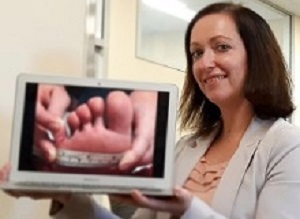
Patients taking medical “selfies” and sharing them with their doctor empowers and reassures healthcare consumers, and can improve doctor-patient relationships, a two-part study led by Queensland University of Technology (QUT) in Brisbane, Australia has found.
Former medical photographer Dr Kara Burns conducted the research as part of her PhD through the QUT Business School. To gauge experiences with and attitudes to consumer-generated health photographs, Burns first interviewed 30 patients, clinicians, and carers.
The second study was a pilot trial with parents taking photos of their children's surgical wounds after they had undergone laparoscopic appendectomy at the Queensland Children's Hospital – 26 parents completed the study, receiving training and then taking photos every two days and emailing the photos to the hospital so that surgeons could review healing. Parents said it improved their confidence in and satisfaction with the medical service, and taking the photos was a useful reminder for them to check how the surgical sites were healing.
Burns said the findings from the photographic trial supported conclusions drawn from the interview study. "The first study asked a range of people what they think about the role of this kind of consumer-generated data, and the second study was to see how people engage with it, as there can be a difference between what people say they will do and what they will do," she said.
"But these two studies largely confirmed each other. Consumers feel this data is valuable, it helps them have a sense of autonomy in their care, improves their view of the service they are being provided, and it enhances the relationship between doctor and patient because there is a sense of mutual respect and communication.
"The parents who took part in the trial said they felt reassured and that the service was going above and beyond. They said normally the door feels shut when you leave a hospital, and providing the photos was a way to stay connected and contact the surgeon afterwards."
Burns said while for clinicians it may be difficult to integrate patient-generated data, such as photographs, video, or information from apps or body monitoring devices, into clinical records, medical professionals should consider it. "This study adds to a body of research that shows there are benefits for clinicians and also for patients in engaging with this kind of patient or carer-generated information," she said.
"If doctors ignore it and don't engage, this research shows that it impacts the service experience and that some patients will switch doctors.
"In one case, a mum had a six-week-old baby who was constantly vomiting, and she felt no one was listening to her concerns. She was so unimpressed by the doctor's responses to her that she changed providers. When she took a video to the next doctor, they assessed that something was wrong and that her daughter needed surgery.
"My Health Record should also consider ways to integrate patient-generated health data. People have expressed concerns about privacy and accessibility but giving them an option to upload their own information may give them a reason to use the portal, to be less fearful of it."
Abstract
Background: Consumer-generated health data (CGHD) are any clinically relevant data collected by patients or their carers (consumers) that may improve health care outcomes. Like patient experience measures, these data reflect the consumer perspective and is part of a patient-centric agenda. The use of CGHD is believed to enhance diagnosis, patient engagement, and thus foster an improved therapeutic partnership with health care providers.
Objective: The aim of this study was to further identify how these data were used by consumers and how it influences engagement via a validated framework. In addition, carer data has not been explored for the purpose of engagement.
Methods: Study 1 used interviews with CGHD-experienced patients, carers, and doctors to understand attitudes about data collection and use, developing an ontological framework. Study 2 was a pilot trial with carers (parents) of children undergoing laparoscopic appendectomy. For 10 days carers generated and emailed surgical site photographs to a tertiary children’s hospital. Subsequently, carers were interviewed about the engagement framework. In total, 60 interviews were analyzed using theme and content analysis.
Results: This study validates a framework anchored in engagement literature, which categorizes CGHD engagement outcomes into 4 domains: physiological, cognitive, emotional, and behavioral. CGHD use is complex, interconnected, and can be organized into 10 themes within these 4 domains.
Conclusions: CGHD can instigate an ecosystem of engagement and provide clinicians with an enhanced therapeutic relationship through an extended view into the patient’s world. In addition to clinical diagnosis and efficient use of health care resources, data offer another tool to manage consumers service experience, especially the emotions associated with the health care journey. Collection and use of data increases consumers sense of reassurance, improves communication with providers, and promotes greater personal responsibility, indicating an empowering consumer process. Finally, it can also improve confidence and satisfaction in the service.
Authors
Kara Burns, Craig A McBride, Bhaveshkumar Patel, Gerard FitzGerald, Shane Mathews, Judy Drennan
[link url="https://www.qut.edu.au/news?id=146468"]Queensland University of Technology material[/link]
[link url="https://www.jmir.org/2019/6/e12367/"]Journal of Medical Internet Research abstract[/link]
